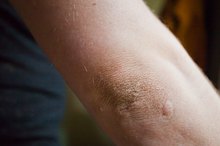How to Get Rid of Dark Spots on Knees
Dark spots on the knees are usually caused by a hyperpigmentation that occurs when the skin is too thick or dry. You can get rid of these dark spots by taking time each week to give your knees the care that they need to stop looking so dark, dry and rough, and go back to looking supple and flesh-colored 1. Use items you likely already have to treat and remove your dark knee spots.
Cut a lemon in half, and rub the pulp and juice over the darkened spots on your knees. Avoid any open cuts or sores, as the acidity of the lemon will sting the skin. Leave the lemon juice on the knees for 10 minutes and let it stay on your skin as you proceed to the next step.
How to Get Rid of Dark Pores on Legs
Learn More
Exfoliate the dead skin from your knees. The darkness is likely caused by your skin becoming thick and dry in that area. The skin on your knees, elbows and feet is naturally thicker and drier than elsewhere on your body because of the amount of strain these areas go through. Use a store-bough exfoliating cream or mix one yourself from brown sugar and olive oil. Rub in circular motions and rinse away.
Rinse away the lemon juice and exfoliating cream. Pat dry with a towel, then apply a rich, emollient moisturizer that's especially formulated for extra dry skin. When the area has been coated, cover it with plastic wrap to make sure that the lotion is completely absorbed by the skin. When it has absorbed, remove the plastic wrap and discard.
Tips
Moisturize your knees daily to keep them looking smooth and bright. Always apply sunscreen; a tan will make your dark spots more noticeable because the dry skin of your knees will tan darker than the rest of your body. If you use a spray tan or a self-tanner, avoid your knees or use a barrier lotion to stop the knees from getting too dark.
Related Articles
References
- American Academy of Dermatology. Variety of Options Available to Treat Pigmentation Problems. February 5, 2013. https://www.aad.org/media/news-releases/variety-of-options-available-to-treat-pigmentation-problems
- Tomecki J, Woodhouse G. Common Benign Growths. Cleveland Clinic Center for Continuing Education. http://www.clevelandclinicmeded.com/medicalpubs/diseasemanagement/dermatology/common-benign-growths/
- Scarcella G, Dethlefsen MW, Nielsen MCE. Treatment of solar lentigines using a combination of picosecond laser and biophotonic treatment. Clin Case Rep. 2018;6(9):1868-1870. doi:10.1002/ccr3.1749
- Scherer D, Kumar R. Genetics of pigmentation in skin cancer--a review. Mutat Res. 2010;705(2):141-53. doi:10.1016/j.mrrev.2010.06.002
- Bastiaens M, Hoefnagel J, Westendorp R, Vermeer BJ, Bouwes bavinck JN. Solar lentigines are strongly related to sun exposure in contrast to ephelides. Pigment Cell Res. 2004;17(3):225-9. doi:10.1111/j.1600-0749.2004.00131.x
- Davis EC, Callender VD. Postinflammatory hyperpigmentation: a review of the epidemiology, clinical features, and treatment options in skin of color. J Clin Aesthet Dermatol. 2010;3(7):20-31.
- George AO, Shittu OB, Enwerem E, Wachtel M, Kuti O. The incidence of lower mid-trunk hyperpigmentation (linea nigra) is affected by sex hormone levels. J Natl Med Assoc. 2005;97(5):685-8.
- Al-saif FM, Baqays AA, Alsaif HF, Alhumidi AA. Erythromelanosis follicularis faciei et colli with reticulated hyperpigmentation of the extremities. Clin Case Rep. 2017;5(10):1576-1579. doi:10.1002/ccr3.1095
- Dereure O. Drug-induced skin pigmentation. Epidemiology, diagnosis and treatment. Am J Clin Dermatol. 2001;2(4):253-62. doi:10.2165/00128071-200102040-00006
- Ammoury A, Michaud S, Paul C, et al. Photodistribution of blue-gray hyperpigmentation after amiodarone treatment: molecular characterization of amiodarone in the skin. Arch Dermatol. 2008;144(1):92-6. doi:10.1001/archdermatol.2007.25
- Jain A, Gupta N. Multifocal Bullous Fixed Drug Erruption Due To Phenytoin: A Lesson Learned! J Clin Diagn Res. 2015;9(12):OD04-5. doi:10.7860/JCDR/2015/15464.6908
- Mccarty M, Rosso JQ. Chronic administration of oral trimethoprim-sulfamethoxazole for acne vulgaris. J Clin Aesthet Dermatol. 2011;4(8):58-66.
- Massinde A, Ntubika S, Magoma M. Extensive hyperpigmentation during pregnancy: a case report. J Med Case Rep. 2011;5:464. doi:10.1186/1752-1947-5-464
- Sarkar SB, Sarkar S, Ghosh S, Bandyopadhyay S. Addison's disease. Contemp Clin Dent. 2012;3(4):484-6. doi:10.4103/0976-237X.107450
- Lause M, Kamboj A, Fernandez faith E. Dermatologic manifestations of endocrine disorders. Transl Pediatr. 2017;6(4):300-312. doi:10.21037/tp.2017.09.08
- Enguita FJ, Leitão AL. Hydroquinone: environmental pollution, toxicity, and microbial answers. Biomed Res Int. 2013;2013:542168. doi:10.1155/2013/542168
- Arora P, Sarkar R, Garg VK, Arya L. Lasers for treatment of melasma and post-inflammatory hyperpigmentation. J Cutan Aesthet Surg. 2012;5(2):93-103. doi:10.4103/0974-2077.99436
- Prohaska J, Badri T. Cryotherapy. StatPearls Publishing. 2019.
- Schalka S. New data on hyperpigmentation disorders. J Eur Acad Dermatol Venereol. 2017;31 Suppl 5:18-21. doi:10.1111/jdv.14411
- American Academy of Dermatology. Variety of Options Available to Treat Pigmentation Problems. February 5, 2013.
- Tomecki J, Woodhouse G. Common Benign Growths. Cleveland Clinic Center for Continuing Education.
Writer Bio
Kay Ireland specializes in health, fitness and lifestyle topics. She is a support worker in the neonatal intensive care and antepartum units of her local hospital and recently became a certified group fitness instructor.









